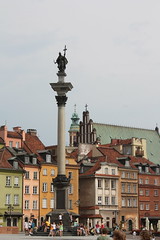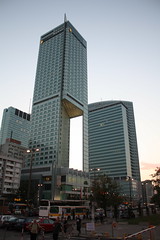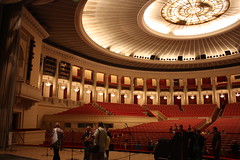This is day two in my "report" of the trip I made to Warsaw with the London Gay Men's Chorus for Europride between 15 and 18 July 2010. The days leading to the trip, the journey itself and the first evening in the city are described here.
Pictures of the day.
The first night in Warsaw, in the luxurious room I had all to myself (it's about the size of my flat!), felt unfortunately quite short, after the previous night's extended meal and meanderings in the unknown city. It was at a time not unlike that of a usual working day that I got up, got ready and went down to breakfast before joining a walking tour of the old town (the area where we were the night before). Meanwhile, others in the Chorus were being packed into an old-fashioned bus for a different sort of tour. More about that later.
Warsaw has, of course, a long history but one mostly marked by conquest, destruction and domination by a foreign power. This is particularly true of the last 200 hundred years. And, as one would expect, this is reflected in the fabric of the city. The second world war and then the soviet domination in particular have been the causes of much destruction and redevelopment.
The central Śródmieście district, which comprises two very distinct areas: the old and the new town, and where we spent most of our time, is probably the part of the city that has seen most of the effects of this.
The old town, which dates back to the 13th century, is picture-postcard pretty, with its old citadel walls, its iggle-piggledy houses of various colours and awkward shapes, and its churches. This is also where the palaces of the former nobility are located.
Many of the buildings are however "fakes". Badly damaged by the Luftwaffe in 1939, who remained of them was systematically blown off by the German army following the Uprising in 1944. After World War II, the Old Town was meticulously rebuilt using original matrials and images, with the last elements of the reconstruction (on the Royal Castle) being finished only in 1974.
The new town has known a totally different fate however. The major part of it is the former location of what was to become the Jewish ghetto. Again most of it was destroyed by the Nazis but this time the freed-up space was used by the new communist masters of the country to express their architectural domination.
Large avenues were carved up through what was left of the old buildings, new squares (such as Constitution Square (Plac Konstytucji) were built in total disregard of the existing street plan and Joseph Stalin planted his controversal Palace of Culture and Science (Pałac Kultury i Nauki or PKiN, a "gift" to Poland and a very conspicuous building in the Warsaw skyline)
On the whole, I can't say I was particularly taken by the city. The fact that it felt pretty empty of people, not at all like a capital city was also a turn off for me. I learned later that it was indeed shockingly empty (even for a local) due to people being on holiday or fleeing the heat (over 30 degrees C) in the countryside.
Warsaw is quite flat and apart from the Town Centre, which boasts a few towers, it is rather low rise and doesn't seem to offer the dramatic views one can find in London.
The two abiding elements of the city for me however will be the birds flying around (particularly swallows which I used to see as a child in my parents' village but seem to have otherwise disappeared) and the lime trees that seem to be the favoured tree to plant along streets. Strangely the locals do not collect their flowers to use as herbal tea.
After the walk that there was time for a visit to the sports area of the hotel, where I had a 10min run before joining the others in the pool area for a swim and a steam.
Soon however, we had to be on our feet again to make our way to the Congress Hall at PKiN for our technical rehearsal. The venue, with its 2500 red seats, used to be the meeting place of the Polish Communist Party and it there that on 29 January 1990, the Party was dissolved. Marlene Dietrich, Louis Armstrong, Jacques Brel, Dalida, The Rolling Stones, Luciano Pavarotti and Eric Clapton, amongst many others, all performed in this space. It is however unlikely that Stalin himself, ever made an appearance on the site, since construction started only a few months before his death in 1953. Other communist leaders, such as Ho Chi Min, did.
I and I think a few other chorines felt truly privileged and humbled to be invited to sing in such a venue. This was also probably a historic moment in its own little way: I can't imagine many gay choirs have performed in there before.
Also singing, was the Stockholm Gaykor. We were performing at as part of an award ceremony for local activists (although UK campaigner Clare Dimyon, who tours eastern European Prides every year and received an MBE this year for her work, was also honoured).
As is often the case, most of the afternoon (and a good part of the evening) was spent waiting. When we arrived to the venue the piano was still being tuned. During the show itself, the speeches and awards elements seem to go on for ever. Although the audience was rather small for such a big venue, they were very appreciative and enthusiastic and our 40min set received a standing ovation.
To conclude the show, the Swedish choir joined us on stage for a rendition of Hej Hej Hej, a very popular Polish song.
After the concert, part of the Chorus went to a pre-organised group meal while others went to (probably gay owned) restaurant near our hotel. I was part of that second group and very much enjoyed the experience and the food.
It seems the other group's evening was a little more eventful, with long delays to be served and fighting in the kitchen...
The piano in the room and our accompanist found themselves united after desert and we sang (mostly to ourselves and the staff) Seasons of Love and Hej Hej Hej.
While some wne to a nearby club, I want to bed.
View YouTube videos of parts of our performance that evening:
Confide in Me (opening of the set)
All I Care About is Love
Boys Will Be Boys with Stockholm Gaykor
All my pictures from the trip are available on my flickr account here.
Part Three is available here.
Pictures of the day.
The first night in Warsaw, in the luxurious room I had all to myself (it's about the size of my flat!), felt unfortunately quite short, after the previous night's extended meal and meanderings in the unknown city. It was at a time not unlike that of a usual working day that I got up, got ready and went down to breakfast before joining a walking tour of the old town (the area where we were the night before). Meanwhile, others in the Chorus were being packed into an old-fashioned bus for a different sort of tour. More about that later.
Warsaw has, of course, a long history but one mostly marked by conquest, destruction and domination by a foreign power. This is particularly true of the last 200 hundred years. And, as one would expect, this is reflected in the fabric of the city. The second world war and then the soviet domination in particular have been the causes of much destruction and redevelopment.
The central Śródmieście district, which comprises two very distinct areas: the old and the new town, and where we spent most of our time, is probably the part of the city that has seen most of the effects of this.
The old town, which dates back to the 13th century, is picture-postcard pretty, with its old citadel walls, its iggle-piggledy houses of various colours and awkward shapes, and its churches. This is also where the palaces of the former nobility are located.
Many of the buildings are however "fakes". Badly damaged by the Luftwaffe in 1939, who remained of them was systematically blown off by the German army following the Uprising in 1944. After World War II, the Old Town was meticulously rebuilt using original matrials and images, with the last elements of the reconstruction (on the Royal Castle) being finished only in 1974.
The new town has known a totally different fate however. The major part of it is the former location of what was to become the Jewish ghetto. Again most of it was destroyed by the Nazis but this time the freed-up space was used by the new communist masters of the country to express their architectural domination.
Large avenues were carved up through what was left of the old buildings, new squares (such as Constitution Square (Plac Konstytucji) were built in total disregard of the existing street plan and Joseph Stalin planted his controversal Palace of Culture and Science (Pałac Kultury i Nauki or PKiN, a "gift" to Poland and a very conspicuous building in the Warsaw skyline)
On the whole, I can't say I was particularly taken by the city. The fact that it felt pretty empty of people, not at all like a capital city was also a turn off for me. I learned later that it was indeed shockingly empty (even for a local) due to people being on holiday or fleeing the heat (over 30 degrees C) in the countryside.
Warsaw is quite flat and apart from the Town Centre, which boasts a few towers, it is rather low rise and doesn't seem to offer the dramatic views one can find in London.
The two abiding elements of the city for me however will be the birds flying around (particularly swallows which I used to see as a child in my parents' village but seem to have otherwise disappeared) and the lime trees that seem to be the favoured tree to plant along streets. Strangely the locals do not collect their flowers to use as herbal tea.
After the walk that there was time for a visit to the sports area of the hotel, where I had a 10min run before joining the others in the pool area for a swim and a steam.
Soon however, we had to be on our feet again to make our way to the Congress Hall at PKiN for our technical rehearsal. The venue, with its 2500 red seats, used to be the meeting place of the Polish Communist Party and it there that on 29 January 1990, the Party was dissolved. Marlene Dietrich, Louis Armstrong, Jacques Brel, Dalida, The Rolling Stones, Luciano Pavarotti and Eric Clapton, amongst many others, all performed in this space. It is however unlikely that Stalin himself, ever made an appearance on the site, since construction started only a few months before his death in 1953. Other communist leaders, such as Ho Chi Min, did.
I and I think a few other chorines felt truly privileged and humbled to be invited to sing in such a venue. This was also probably a historic moment in its own little way: I can't imagine many gay choirs have performed in there before.
Also singing, was the Stockholm Gaykor. We were performing at as part of an award ceremony for local activists (although UK campaigner Clare Dimyon, who tours eastern European Prides every year and received an MBE this year for her work, was also honoured).
As is often the case, most of the afternoon (and a good part of the evening) was spent waiting. When we arrived to the venue the piano was still being tuned. During the show itself, the speeches and awards elements seem to go on for ever. Although the audience was rather small for such a big venue, they were very appreciative and enthusiastic and our 40min set received a standing ovation.
To conclude the show, the Swedish choir joined us on stage for a rendition of Hej Hej Hej, a very popular Polish song.
After the concert, part of the Chorus went to a pre-organised group meal while others went to (probably gay owned) restaurant near our hotel. I was part of that second group and very much enjoyed the experience and the food.
It seems the other group's evening was a little more eventful, with long delays to be served and fighting in the kitchen...
The piano in the room and our accompanist found themselves united after desert and we sang (mostly to ourselves and the staff) Seasons of Love and Hej Hej Hej.
While some wne to a nearby club, I want to bed.
View YouTube videos of parts of our performance that evening:
Confide in Me (opening of the set)
All I Care About is Love
Boys Will Be Boys with Stockholm Gaykor
All my pictures from the trip are available on my flickr account here.
Part Three is available here.



No-one collects the flowers because of air pollution.
ReplyDelete